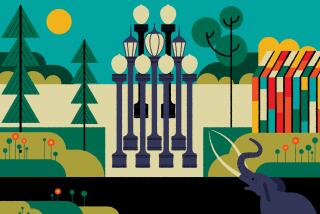Glasgow Museum Is a Woodland Treasure
- Share via
When the whole world is not a stage, it is a museum: a changing exhibition of art and craft, of light and motion, of space and design, of what is and what is not.
There are national parks, sculpture gardens and restored villages that call themselves museums without walls.
There are behemoth museums of warehouse mentality, where vast treasures are crammed into dark and dusty cases in dark and dusty rooms. There are art museums where masterworks are hung in shadows, or near a dim yellow bulb that robs the luster.
The New Museums
Then there are new museums, places that gladden the heart and eye and spirit, museums that use architectural design and space and setting to honor and ennoble their collections.
The Louisiana Museum of Modern Art, sprawled on the Danish coast outside Copenhagen, was an early winner in this marriage of nature and art, of tall trees and Giacometti sculptures, of sloping parkland and soaring mobiles.
The Museum of Anthropology on a sea cliff at the western rim of Vancouver, near the University of British Columbia, is a mystical meeting ground of fir and cedar and totem poles brought from Pacific Northwest villages.
Now comes the Burrell Collection, which nestles boldly into the woodland of Pollok Park in Glasgow. Its high-pitched glass walls with light oak beams blend the tremulous beauty outdoors with the ancient beauty inside.
If it is snowing in Glasgow, a shawl of white will be snagged on bare branches behind a Ming Dynasty stone figure of a disciple of Buddha who sits in grand serenity on a pedestal. Behind him, in the spring, is a carpet of bluebells; with autumn comes a tawny screen of gold. This magical place is enhanced by walls of pale red sandstone, a brushed and mellow stone used in many Victorian and Edwardian houses in Glasgow.
The Burrell is different from many museums because it is not a cumbersome creature of added wings. It was designed to display the private collection of one man--the late Scot shipbuilder Sir William Burrell. Its 8,000 items do not reflect a nation’s plunder nor a city’s attic. They mirror the spunk, wealth, quirks and passions of an individual. Burrell died in 1958; his treasures were not seen by the public until Queen Elizabeth opened the double oak doors in Pollok Park in 1983.
Order to the Maze
There are Egyptian artifacts, Roman glass, French and German altarpieces. Yet nothing is jumbled; there is order to the maze. Three rooms were moved here from Hutton Castle near Berwick-on-Tweed, the Burrell family home.
The textile collection is impressive; the tapestries, more than 150 from the 14th to the 16th centuries, are wondrous. Burrell collected medieval stained glass windows, limestone portals, 16th-Century weapons and fragile lace cuffs.
Not to mention Rembrandts, Renoirs and Rodins--all are here.
The Burrell is worth a journey from anywhere, and certainly a shuttle from London.
In fact, one of the offbeat things to do in Edinburgh these days is to slip away to Glasgow and the Burrell.
More to Read
The biggest entertainment stories
Get our big stories about Hollywood, film, television, music, arts, culture and more right in your inbox as soon as they publish.
You may occasionally receive promotional content from the Los Angeles Times.








